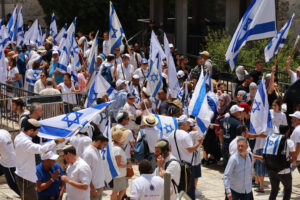OpEds
Yom Yerushalayim – another tense moment for Israel
On 28 Iyar, corresponding to 19 May this year, Israel and the diaspora will mark Yom Yerushalayim. This day commemorates the recapture of East Jerusalem from Jordan by Israel in the June 1967 Six-Day War, and the subsequent reunification of the city as Israel’s “eternal capital”.
The day has developed into a show of nationalism, especially by religious Zionists. They take part in a loud – some would say provocative – march and the “Dance of Flags” through the city’s iconic limestone streets to the Kotel. This year, as Israel reels from internal demonstrations against proposed judicial reforms and a shaky ceasefire with militants who recently fired hundreds of missiles on Israel from Gaza, the day could be another flashpoint for a country on edge.

Palestinians and their supporters have long resisted what they see as Israel’s attempts to “Judaize” Jerusalem. There are periodic – but entirely false – rumours that Israel intends to cause harm to or change the status of the Al-Aqsa Mosque and the Dome of the Rock on the Temple Mount, known as al-Haram al-Sharif to Muslims. These sacred buildings are still under the auspices of the Jordanian waqf, with Israel controlling security. These lies raise the temperature on the Temple Mount, in the city, across the country, and through the Muslim world.
For instance, in January 2023, Itamar Ben-Gvir, Israel’s new security minister from the far-right Jewish National Front party, visited the Temple Mount. The terror group, Hamas, said this was “a deliberate provocation”, and several Israeli politicians advised him against it. Hamas spokesman Hazem Qassem told Al Jazeera that Ben-Gvir’s “storming” of Al-Aqsa was “a continuation of the Zionist occupation’s aggression against our sanctities and its war on their Arab identity”.
Ben-Gvir brazenly showed his defiance of Hamas, and did his walkabout. Representing a religious Zionist constituency that Prime Minister Benjamin Netanyahu needs to keep his governing coalition together, Ben-Gvir wasn’t going to be told where he could or couldn’t walk. He’s in favour of Jews being allowed to pray on the Temple Mount, which they are currently not allowed to do.
Ben-Gvir will participate in this year’s ultranationalist Yom Yerushalayim march, which again could spark violence as it did in 2021. The police have been condemned by right-wingers for attempting to reroute the march away from Arab neighbourhoods. Senior politicians such as Finance Minister Bezalel Smotrich and Transportation Minister Miri Regev are also likely to march. They are among those driving proposed judicial reforms that protesters across the country have said undermine Israel’s democracy.
A fragile ceasefire with Palestinian Islamic Jihad is in effect at the time of writing, following five days of fighting where almost 1 500 rockets were fired at Israel from Gaza. This could be in danger as the noisy march celebrates the defeat of Arab armies and their humiliation in 1967.
Jerusalem is never far from controversy. On 14 May 2018 – Israel’s 70th Independence Day – the United States under President Donald Trump finally moved the US Embassy to Jerusalem from Tel Aviv, fulfilling a promise made in the Clinton Administration in 1995. Palestinians claimed this was tantamount to recognition of Israeli occupation in East Jerusalem. Jews maintain that they don’t need anyone to tell them where Israel’s capital is. On that day, 57 people were killed in protests at Gaza’s border with Israel linked to the relocation.
Only Guatemala and Paraguay said they would move their missions to Jerusalem, but the latter reversed this decision when the government changed after elections.
In 2021, disagreement again erupted over planned evictions of Arab families in the Sheik Jarrah neighbourhood in Jerusalem, leading to clashes between Israeli security forces and Palestinians. It was seen as a miniature version of the whole Israeli-Palestinian conflict, with the emotive issues of land, rights, and identity at its heart.
Back in 1967, Israel’s defence minister Moshe Dayan said, “This morning, the Israel Defense Forces liberated Jerusalem. We have united Jerusalem, the divided capital of Israel. We have returned to the holiest of our holy places, never to part from it again. To our Arab neighbours, we extend, also at this hour—and with added emphasis at this hour—our hand in peace. And to our Christian and Muslim fellow citizens, we solemnly promise full religious freedom and rights. We did not come to Jerusalem for the sake of other peoples’ holy places, and not to interfere with the adherents of other faiths, but in order to safeguard its entirety, and to live there together with others, in unity.”
But this has never been easy in the city King David is said to have made his capital more than 3 000 years ago. It has been attacked and conquered numerous times over the centuries, and remains a holy city to three monotheistic religions – Judaism, Christianity, and Islam. Let’s hope tension doesn’t boil over into more deadly violence this year.
- Steven Gruzd is an analyst at the South African Institute of International Affairs. He writes in his personal capacity.